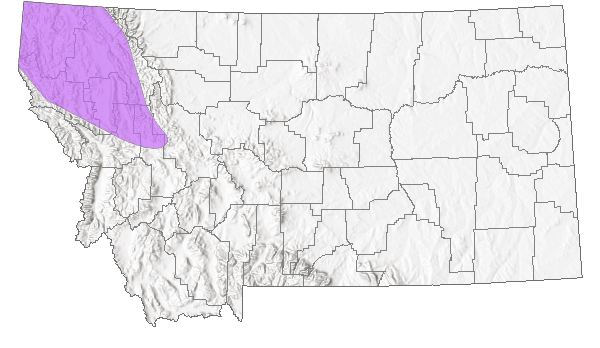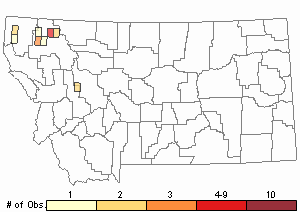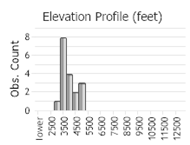View in other NatureServe Network Field Guides
NatureServe
Montana
Utah
Wyoming
Idaho
Wisconsin
British Columbia
South Carolina
Yukon
California
New York
Creeping Sedge - Carex chordorrhiza
State Rank Reason (see State Rank above)
Rare in Montana, where it is known from fens and wet meadows in the northwest corner of the state. Generally does not appear to be threatened by any particular activities, though populations are susceptible to hydrologic changes.
General Description
Stoloniferous. Stems usually prostrate, clothed in old leaf bases, 10–25 cm. Leaves cauline; blades 1–2 mm wide, channeled . Inflorescence of 3 to 5 sessile spikes, densely aggregated, appearing like 1 ovoid head; lowest bract scale-like. Spikes 4–8 mm long, all similar; male flowers above, few female below. Perigynia spreading to ascending, brown, ovoid, 2.5–3.5 mm, with an entire beak 0.5 mm long; stigmas 2. Female scales brown with a pale midvein and margins, ca. as long as the perigynia. Achene 2-sided, filling the perigynium (
Lesica et al. 2012. Manual of Montana Vascular Plants. BRIT Press. Fort Worth, TX).
Phenology
Fruit matures in July.
Diagnostic Characteristics
The strict peatland habitat and small heads help distinguish this species. Carex simulata also occurs in mires but has smaller perigynia with more than 5 per spike. A hand lens and technical manual should be used for positive identification.
Species Range
Montana Range
Range Descriptions

 Native
Native
Range Comments
Circumboreal south to OR, MT, IN and NY (Lesica et al. 2012. Manual of Montana Vascular Plants. BRIT Press. Fort Worth, TX).
Observations in Montana Natural Heritage Program Database
Number of Observations: 21
(Click on the following maps and charts to see full sized version)
Map Help and Descriptions
Relative Density

Recency



 (Observations spanning multiple months or years are excluded from time charts)
(Observations spanning multiple months or years are excluded from time charts)
Habitat
Wet, organic soil of fens in the montane zone.
National Vegetation Classification System Groups Associated with this Species
Wetland and Riparian
Peatland
Stewardship Responsibility
Threats or Limiting Factors
STATE THREAT SCORE REASON
Threat impact not assigned because threats are not known (MTNHP Threat Assessment 2021).
References
- Literature Cited AboveLegend:
 View Online Publication
View Online Publication Lesica, P., M.T. Lavin, and P.F. Stickney. 2012. Manual of Montana Vascular Plants. Fort Worth, TX: BRIT Press. viii + 771 p.
Lesica, P., M.T. Lavin, and P.F. Stickney. 2012. Manual of Montana Vascular Plants. Fort Worth, TX: BRIT Press. viii + 771 p. MTNHP Threat Assessment. 2021. State Threat Score Assignment and Assessment of Reported Threats from 2006 to 2021 for State-listed Vascular Plants. Botany Program, Montana Natural Heritage Program, Helena, Montana.
MTNHP Threat Assessment. 2021. State Threat Score Assignment and Assessment of Reported Threats from 2006 to 2021 for State-listed Vascular Plants. Botany Program, Montana Natural Heritage Program, Helena, Montana.
- Additional ReferencesLegend:
 View Online Publication
View Online Publication
Do you know of a citation we're missing? Bernard, J. M. 1989. Life history and vegetative reproduction in Carex. Canadian Journal of Botany 68: 1441-1448.
Bernard, J. M. 1989. Life history and vegetative reproduction in Carex. Canadian Journal of Botany 68: 1441-1448. Bowles, M. L., M. M. DeMauro, N. Pavlovic, and R. D. Hiebert. 1990. Effects of anthropogenic disturbances on endangered and threatened plants at the Indiana Dunes National Lakeshore. Natural Areas Journal. 10(4): 187-200.
Bowles, M. L., M. M. DeMauro, N. Pavlovic, and R. D. Hiebert. 1990. Effects of anthropogenic disturbances on endangered and threatened plants at the Indiana Dunes National Lakeshore. Natural Areas Journal. 10(4): 187-200. Bowles, M. L., W. J. Hess, and M. M. DeMauro. 1985. An assessment of the monitoring program for special floristic elements at Indiana Dunes National Lakeshore. Phase 1. The endangered species. Unpublished report prepared for the Morton Arborrtum, Lisle, IL.
Bowles, M. L., W. J. Hess, and M. M. DeMauro. 1985. An assessment of the monitoring program for special floristic elements at Indiana Dunes National Lakeshore. Phase 1. The endangered species. Unpublished report prepared for the Morton Arborrtum, Lisle, IL. Bowles, M.L., W. J. Hess,M.M. DeMauro, and R.D. Hiebert. 1986. Endangered plant inventory and monitoring strategies at Indiana Dunes National Lakeshore. Natural Areas Journal. 6(1): 18-26.
Bowles, M.L., W. J. Hess,M.M. DeMauro, and R.D. Hiebert. 1986. Endangered plant inventory and monitoring strategies at Indiana Dunes National Lakeshore. Natural Areas Journal. 6(1): 18-26. Bursik, Rob. 1988. Rare plant data from specimens at the University of Idaho Herbarium, Moscow.
Bursik, Rob. 1988. Rare plant data from specimens at the University of Idaho Herbarium, Moscow. Ebersole, J. L. 1987. Short-term vegetation recovery at an Alaskan arctic coastal plain site. Arctic and Alpine Research. 19(4): 442-450.
Ebersole, J. L. 1987. Short-term vegetation recovery at an Alaskan arctic coastal plain site. Arctic and Alpine Research. 19(4): 442-450. Fernald, M. L. 1919. Lithological factors limiting the ranges of Pinus banksiana and Thuja occidentalis. Rhodora 21(243): 41-67.
Fernald, M. L. 1919. Lithological factors limiting the ranges of Pinus banksiana and Thuja occidentalis. Rhodora 21(243): 41-67. Haag, R. W. 1974. Nutrient limitations to plant production in two tundra communities. Canadian Journal of Botany 52: 103-116.
Haag, R. W. 1974. Nutrient limitations to plant production in two tundra communities. Canadian Journal of Botany 52: 103-116. Hutchings, M. J. 1979. Weight-density relationships in ramet populations of clonal perennial herbs, with special reference to the -3/2 power rule. Journal of Ecology 67(1): 21-33.
Hutchings, M. J. 1979. Weight-density relationships in ramet populations of clonal perennial herbs, with special reference to the -3/2 power rule. Journal of Ecology 67(1): 21-33. Jankovska, V., and K. Rybnicek. 1988. The genus Carex in the Late Glacial and Holocene of Czechoslovakia. Aquatic Botany 30: 23-37.
Jankovska, V., and K. Rybnicek. 1988. The genus Carex in the Late Glacial and Holocene of Czechoslovakia. Aquatic Botany 30: 23-37. Kershaw, K. A. 1974. Studies on lichen-dominated systems. X. The sedge meadows of the coastal raised beaches. Canadian Journal of Botany 52: 1947-1972.
Kershaw, K. A. 1974. Studies on lichen-dominated systems. X. The sedge meadows of the coastal raised beaches. Canadian Journal of Botany 52: 1947-1972. Lesica, P. 1994. The distribution of plant community diversity associated with glacial wetlands in the Ovando Valley, Montana. [Unpublished report.] The Nature Conservancy, Montana Field Office, Helena. 26 pp.
Lesica, P. 1994. The distribution of plant community diversity associated with glacial wetlands in the Ovando Valley, Montana. [Unpublished report.] The Nature Conservancy, Montana Field Office, Helena. 26 pp. Lesica, P., M.T. Lavin, and P.F. Stickney. 2022. Manual of Montana Vascular Plants, Second Edition. Fort Worth, TX: BRIT Press. viii + 779 p.
Lesica, P., M.T. Lavin, and P.F. Stickney. 2022. Manual of Montana Vascular Plants, Second Edition. Fort Worth, TX: BRIT Press. viii + 779 p. Nicholson, B. J., and D. H. Vitt. 1990. The paleoecology of a peatland complex in continental western Canada. Canadian Journal of Botany. 68(1): 121-138.
Nicholson, B. J., and D. H. Vitt. 1990. The paleoecology of a peatland complex in continental western Canada. Canadian Journal of Botany. 68(1): 121-138. Page, S. E., and J. O. Rieley. 1985. The ecology and distribution of Carex chordorrhiza L. fil. Watsonia 15: 253-259.
Page, S. E., and J. O. Rieley. 1985. The ecology and distribution of Carex chordorrhiza L. fil. Watsonia 15: 253-259. Schuyler, A.E. 1980. Carex chordorrhiza in Glacier National Park, Montana. Rhodora 82:519.
Schuyler, A.E. 1980. Carex chordorrhiza in Glacier National Park, Montana. Rhodora 82:519. Slack, N. G., D.H. Vitt, and D.G. Horton. 1980. Vegetation gradients of minerotrophically rich fens in western Alberta. Canadian Journal of Botany 58: 330-350.
Slack, N. G., D.H. Vitt, and D.G. Horton. 1980. Vegetation gradients of minerotrophically rich fens in western Alberta. Canadian Journal of Botany 58: 330-350.
- Web Search Engines for Articles on "Creeping Sedge"





